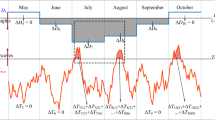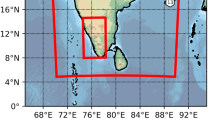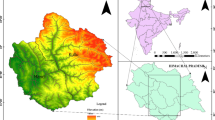Abstract
Predicting and analyzing wet/dry spells characteristics are vital for an appropriate understanding of climate change and its impacts on water resources management, particularly in arid and semiarid regions. Based on the downscaled precipitation series retrieved from the large-scale outputs of CanESM2 climate model under RCPs scenarios, wet/dry spells characteristics were analyzed during 2011–2040, in one of the most vulnerable arid and semiarid basins located in the Southern Alborz region, Iran. The results suggest that the mean wet spells number decreases during the 2020s period under RCP 2.6, 4.5, and 8.5 scenarios, while mean dry spells number indicates increasing values for the near future compared with the baseline. Moreover, short-length wet spells are dominant, while dry spells with medium durations are prevailing in the study region. On the other hand, dry spells persistence is much higher than those of wet spells, although there is no significant difference among the average wet spells number. Furthermore, there is not any significant difference among the persistence of wet spells under various RCPs scenarios. These results illustrate that the risk of flood events will be alleviated in the region ,whereas the risk of longer droughts events will increase. The main findings of this study show that analyzing the characteristics of wet/dry spells can lead to more accurate and efficient strategies to have sustainable resources management under the changing climate.








Similar content being viewed by others
References
Abbaspour M, Sabetraftar A (2005) Review of cycles and indices of drought and their effect on water resources, ecological, biological, agricultural, social and economical issues in Iran. Int J Environ Stud 62:709–724
Abbaspour KC, Faramarzi M, Ghasemi SS, Yang H (2009) Assessing the impact of climate change on water resources in Iran. Water Resour Res 45
Almazroui M, Islam MN, Alkhalaf A, Saeed F, Dambul R, Rahman MA (2016) Simulation of temperature and precipitation climatology for the CORDEX-MENA/Arab domain using RegCM4. Arab J Geosci 9:13
Almazroui M, Balkhair KS, Islam MN, Şen Z (2017) Climate change impact on monthly precipitation wet and dry spells in arid regions: case study over Wadi Al-Lith Basin. Adv Meteorol:2017
Anandhi A, Hutchinson S, Harrington J, Rahmani V, Kirkham MB, Rice CW (2016) Changes in spatial and temporal trends in wet, dry, warm and cold spell length or duration indices in Kansas, USA. Int J Climatol 36:4085–4101
Angel J (2008) Potential impacts of climate change on water availability. Illinois State Water Survey, Institute of Natural Resources Sustainability 12:397–409
Arora V et al (2009) The effect of terrestrial photosynthesis down regulation on the twentieth-century carbon budget simulated with the CCCma Earth System Model. J Clim 22:6066–6088
Bärring L, Holt T, Linderson M-L, Radziejewski M, Moriondo M, Palutikof JP (2006) Defining dry/wet spells for point observations, observed area averages, and regional climate model gridboxes in Europe. Clim Res 31:35–49
Blenkinsop S, Fowler H (2007) Changes in drought frequency, severity and duration for the British Isles projected by the PRUDENCE regional climate models. J Hydrol 342:50–71
Ehsan MA, Almazroui M, Yousef A (2017) Impact of different cumulus parameterization schemes in SAUDI-KAU AGCM. Earth Syst Environ 1:3
Eskandari H, Borji M, Khosravi H, Mesbahzadeh T (2016) Desertification of forest, range and desert in Tehran province, affected by climate change. Solid Earth 7:905–915
Fakhri M, Farzaneh MR, Eslamian S, Khordadi MJ (2012) Confidence interval assessment to estimate dry and wet spells under climate change in Shahrekord Station, Iran. J Hydrol Eng 18:911–918
Feyerherm A, Bark LD (1967) Goodness of fit of a Markov chain model for sequences of wet and dry days. J Appl Meteorol 6:770–773
Field CB et al (2014) IPCC, 2014: Climate change 2014: impacts, adaptation, and vulnerability. Part a: global and sectoral aspects. Contribution of working group II to the fifth assessment report of the intergovernmental panel on climate change. Cambridge University Press, Cambridge and New York
Houghton JT et al (2001) Technical summary of working group 1. Cambridge University Press
Huang J, Chen X, Xue Y, Lin J, Zhang J (2017) Changing characteristics of wet/dry spells during 1961–2008 in Sichuan province, Southwest China. Theor Appl Climatol 127:129–141
Jahani HR, Reyhani M (2007) Role of groundwater in Tehran water crisis mitigation the designations employed and the presentation of material throughout the publication do not imply the expression of any opinion whatsoever on the part of UNESCO concerning the legal status of any country, territory, city or of its authorities, or concerning the delimitation of its frontiers or boundaries:115
Li Z, Li Y, Shi X, Li J (2017) The characteristics of wet and dry spells for the diverse climate in China. Glob Planet Chang 149:14–19
Madani K (2014) Water management in Iran: what is causing the looming crisis? J Environ Stud Sci 4:315–328
Mirdashtvan M, Najafinejad A, Malekian A, Sa'doddin A (2018) Downscaling the contribution to uncertainty in climate-change assessments: representative concentration pathway (RCP) scenarios for the South Alborz Range, Iran. Meteorol Appl 25:414–422
Modarres R (2010) Regional dry spells frequency analysis by L-moment and multivariate analysis. Water Resour Manag 24:2365–2380
Nasri M, Modarres R (2009) Dry spell trend analysis of Isfahan Province, Iran. Int J Climatol 29:1430–1438
Nazemosadat M, Ghasemi A (2004) Quantifying the ENSO-related shifts in the intensity and probability of drought and wet periods in Iran. J Clim 17:4005–4018
Saaroni H, Ziv B, Lempert J, Gazit Y, Morin E (2015) Prolonged dry spells in the Levant region: climatologic-synoptic analysis. Int J Climatol 35:2223–2236
Sarhadi A, Heydarizadeh M (2014) Regional frequency analysis and spatial pattern characterization of dry spells in Iran. Int J Climatol 34:835–848
Şen Z (2015) Applied drought modeling, prediction, and mitigation. Elsevier
Solomon S et al (2007) Contribution of working group I to the fourth assessment report of the intergovernmental panel on climate change, 2007. Cambridge University Press, Cambridge
Stocker T (2014) Climate change 2013: the physical science basis: working group I contribution to the fifth assessment report of the intergovernmental panel on climate change. Cambridge University Press
Taylor KE, Stouffer RJ, Meehl GA (2012) An overview of CMIP5 and the experiment design. Bull Am Meteorol Soc 93:485–498
Vinnarasi R, Dhanya C (2016) Changing characteristics of extreme wet and dry spells of Indian monsoon rainfall. J Geophys Res Atmos 121:2146–2160
Wilby R (1998) Statistical downscaling of daily precipitation using daily airflow and seasonal teleconnection indices. Clim Res 10:163–178
Wilby R, Dawson C (2007) Using SDSM version 4.1 SDSM 4.2. 2—a decision support tool for the assessment of regional climate change impacts User Manual, Leicestershire, UK
Wilby RL, Dawson CW (2013) The statistical downscaling model: insights from one decade of application. Int J Climatol 33:1707–1719
Wilby RL, Hassan H, Hanaki K (1998) Statistical downscaling of hydrometeorological variables using general circulation model output. J Hydrol 205:1–19
Xu K, Yang D, Yang H, Li Z, Qin Y, Shen Y (2015) Spatio-temporal variation of drought in China during 1961–2012: A climatic perspective. J Hydrol 526:253–264
Author information
Authors and Affiliations
Corresponding author
Additional information
Responsible Editor: Zhihua Zhang
Rights and permissions
About this article
Cite this article
Mirdashtvan, M., Malekian, A. A regional assessment of wet/dry spells characteristics using RCPs scenarios in a semiarid region. Arab J Geosci 13, 781 (2020). https://doi.org/10.1007/s12517-020-05778-w
Received:
Accepted:
Published:
DOI: https://doi.org/10.1007/s12517-020-05778-w




